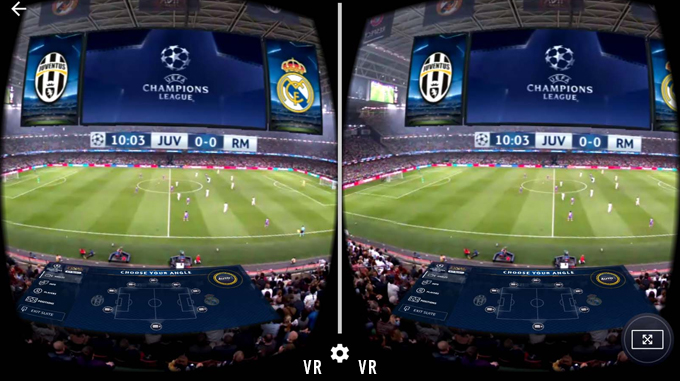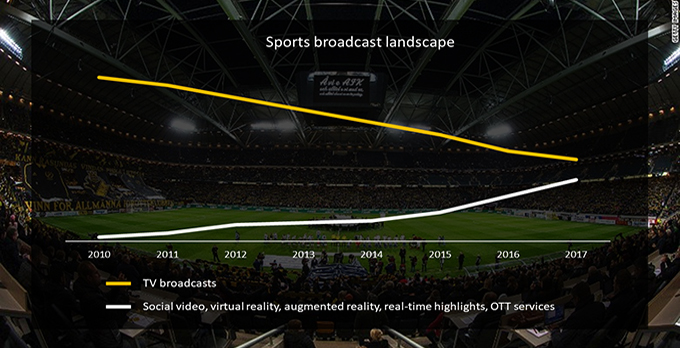
Sport is changing. The market for sports is changing too. Audiences are failing to identify with linear sports programming and TV ratings are down for many major sports properties in Europe and North America. Yet we might argue that sports fans are watching more sport and consuming more information about sports than ever before. Technology is driving this change.
Live streaming, over-the-top service delivery, mobile applications, social video, virtual reality, augmented reality, performance insights and real-time highlights make up a digital landscape that has impacted the global sports industry. Technology has brought fans closer to the action and with improvements in internet connectivity and the rapid adoption of smartphones and social networks, viewers have more options available to them than ever before.
Today, fans don’t have to go to a game or rely on linear TV broadcasts to follow the action and this has significant implications for how sport evolves in the next decade and beyond.
Social networks such as Facebook, Twitter, Snapchat and WeChat have played a key role in this change in consumption, with mobile and video at the centre. At Grabyo we have seen rapid growth of social and digital video in the last three years - with growth accelerating in most markets.
Sport fans, like all consumers, face a myriad of choices for attention and social networks present an immediate, global platform for rights owners to deliver content - building direct relationships with the audience and raising levels of engagement.
The introduction of live streaming and OTT, and more recently the introduction of broadcast-quality streams on social platforms, have enabled fans to experience live sport away from the TV. Athletes, teams and leagues have been able to break down the barriers of traditional linear TV production to deliver authentic, live broadcasts focused on this expanding digital audience.
This new method of ‘broadcasting’ creates an ecosystem that is less reliant on traditional TV, cable or radio - and more importantly, it’s aligned to the behaviour of the next generation of fans.
Technology is not just changing the way audiences consume content, it is also changing the way broadcasters and rights-holders deliver content. In 2017, for the first time, BT Sport streamed the Champions League final live in 360 VR on YouTube and BT Sports apps. This was a unique experience for the fans, bringing them closer to the action than ever before. Fans could choose their own view of the final, direct from mobile (or VR headset), giving them access to live footage which was not available on the TV.
Technology such as VR and AR facilitate a region-free change for sports. Fans are no longer limited by their geographical proximity to an event. Facebook has indicated that there are more than 500 million soccer fans on the platform, many of whom will follow the top teams in the Premier League and LaLiga, but few of whom will ever be able to watch a game live in the stadium.
The chance to experience the game from a local fan’s point of view in VR is a huge opportunity to increase engagement, and new revenues, from this global fan base - we just need to wait for the technology to catch up with the potential.
Live streams, wearable technologies, performance tracking, fan engagement apps and social media platforms are now part of a sports industry that gives fans more information, more access and more options for content than ever before. The impact of mobile and social means that fans don’t go looking for information about sports, the information finds them.
Twenty years ago, I would spend my Saturdays sitting in front of the television watching CEEFAX page 303, waiting for the page to turn to see whether Southampton FC had scored in the English Premier League. Today I am more likely to turn my phone off so I can watch the highlights on catch-up without knowing the result. Having access to information everywhere changes the way we consume content and impacts the demands from consumers.

Soon it will no longer be enough to deliver in-play highlights, images and live tweets at an event - fans will demand the ability to feel like they are there, to experience sport through a mobile device that more accurately represents the real thing; that’s if being at the venue is still considered ‘real’ in the future. Consumers will want to choose what to watch and when to watch on every platform or device. Updates will be personalised, direct and delivered in real time.
Social experiences will change with technology too. We will move on from today’s WhatsApp groups and Twitter feeds to share banter with friends and fans, to dedicated virtual experiences that replicate stadiums, bars and living rooms across the world. For an early view of this, check out LiveLike’s plans for social avatar viewing in VR. It’s not quite like sitting next to your friends on the couch yet, but we will get there in time.
With 7 billion people expected to be connected to the internet by 2020, sports audiences across digital and social platforms will grow exponentially. This presents leagues, federations and sports teams the opportunity to globalise and monetize at scale. As advertising dollars slowly begin to migrate from traditional TV to OTT, social and digital, rights-holders that can embrace change, leverage social audiences and build direct relationships with fans will be highly sought after.
Technology will impact the production, distribution, consumption and monetisation of sport and will continue to influence the development of sports performance. Vast quantities of data made available to coaching staff enables educated and informed decisions on training load, personalised development programs, nutrition, hydration and biometric activity... too much to address here, a topic for a future column maybe.
Over the next five years, technology will shape how audiences and fans interact with sports, it will impact sports formats and the frequency of consumption, provide data and feedback to better understand the needs of fans and improve the viewing experience. As 5G connectivity rolls out across North America and Europe and broadcasters and rights holders begin to harness and utilise the power of cloud-based platforms, sport will become increasingly dependent on technology.
If the music industry offers a glimpse of the future we should expect rapid change, disruption and some challenging times ahead but the longer-term future is bright as a new industry emerges, shaped by the needs of its fans.
This article was originally published by our partner Sportcal. The original article can be viewed here .
Give your career in sport a boost with the latest live vacancies , or create an account today and stay up to date with all the latest industry knowledge, events and jobs in sport.
Global Sports: the world’s leading specialist careers platform for the international sports industry